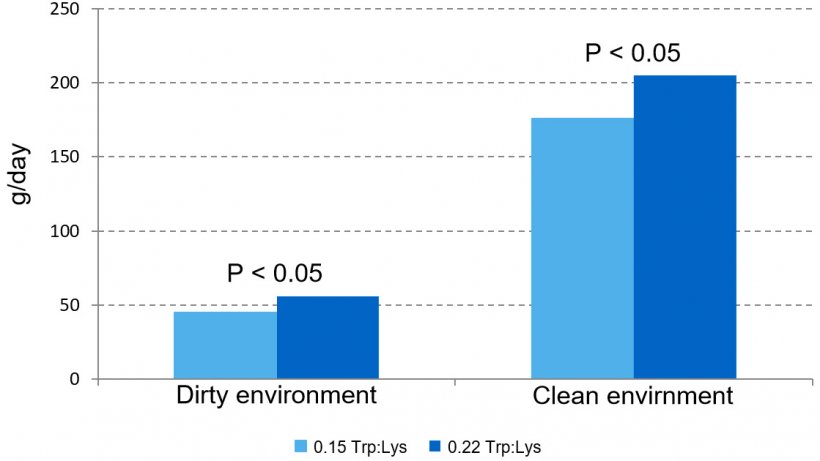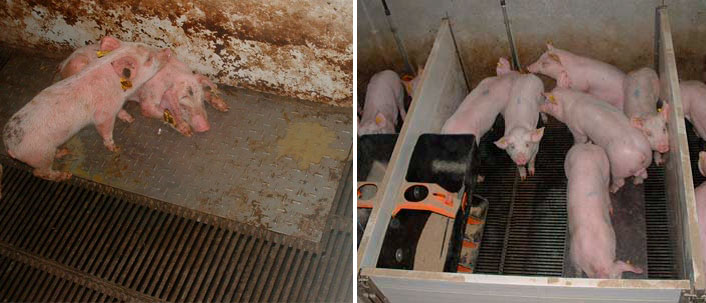Optimizing animal health increases the human food safety and improves animal welfare and profits of pig producers. Therefore, in the last years considerable research effort has been focused to identifying nutrients or feeding strategies that benefit the immune system to face pathogens invasion. In pig production, especial attention has been paid to the immediate post-weaning period, one of the most stressful events in the pig’s life.
Stress promoted during the weaning process alters pro-inflammatory cytokines, which have an influence on intestinal integrity. When the intestinal barrier is disrupted, the result is increased permeability that allows toxins, bacteria, or antigens to cross the epithelium resulting in inflammation, mal-absorption, diarrhea, and reduced growth. Thus, weaning stress impacts intestinal integrity and active immune response.

The classic responses observed with immune system activation and cytokine production include anorexia, fever, reduction of muscle protein synthesis and increase of muscle protein degradation, resulting in lower protein accretion rate. Nutritionally anorexia is, by far, the biggest impact of the stress response. Many cytokines are potentially anorexigenic, which can decrease feed intake by more than 50% during the acute phase of an infectious challenge. Therefore, because of decreased energy intake, the energy needed to protein synthesis is also decreased, suggesting that energy:lysine ratio will be not affected. Some authors think nutritionists should not modify the diet, limit feed, or add expensive feed additives during an immune challenge. However, different approaches have been successfully tested to improve pigs’ ability to face pathogens, either improving immunological response or preventing the pathogens from adhering to intestinal mucosa.
During the immune system activation, the metabolic state is switched from protein deposition in healthy animals to catabolism and muscle degradation in immune challenged pigs. Most of amino acids obtained from muscle protein degradation are used for the synthesis of immunoglobulins and acute phase proteins, leading to a totally different pattern of amino acid requirements. Compared with skeletal muscle proteins acute-phase proteins have higher concentrations of aromatic amino acids (phenylalanine, tyrosine and tryptophan), while threonine is a major component of immunoglobulin-G. Therefore, it is possible that immune system activation affects the utilization of some amino acids relative to lysine and their content should be increased in diets in immune challenge situations. Threonine is involved in biological functions such as gut integrity and immunity. Thus, a deficiency in threonine leads to disorders in the digestive physiology. Tryptophan concentration decreases in plasma during an inflammatory response indicating that its availability for growth may be compromised. In a study conducted in our research center, two different dietary Trp:Lys ratios were compared in the immediate post-weaning phase, 15% vs 22% of Lys, in two different sanitary conditions (Figure 1). Increasing Trp:Lys ratio improved growth performance in both situations, although a greater response was observed in pigs reared in a dirty environment (24.4% vs 16.5% of improvement in growth rate in dirty vs clean environment, respectively). In figure 2, some pigs reared in dirty and clean conditions in this study are shown.

*Data of the author, not published (2009)

Regarding feeding approaches that prevent the pathogens from adhering to intestinal tissue, the most efficient and more practical to be applied in field conditions are the use of low-protein diets, the use of high-fiber ingredients and restricted feeding. Decreasing the dietary crude protein, maintaining amino acid requirements, allows decreasing the undigested protein entering the large intestine and then the substrate for pathogens. In addition, the production of toxic nitrogenous compounds including ammonia is harmful to intestinal health. Restrictive feeding will also contribute to decrease undigested feed entering the large intestine and therefore less substrate for the pathogens. In contrast, high fermentable fiber compounds will stimulate fermentation in the hind gut, increasing production of short chain fatty acids which stimulate water and electrolytes absorption, improve gut morphology, and reduce colonic pH to levels that are unfavourable for pathogens. As a result, all three methods contribute to decrease incidence of diarrhea and other intestinal problems.
In conclusion, biological alterations in immune and intestinal systems occur immediately after weaning that affect subsequent pig growth and health. Swine producers should utilize appropriate health and management strategies, but also nutrition or feeding approaches which help to minimize the adverse events of weaning stress, especially in low-health status farms with higher challenge to pathogens exposure. In these farms, specific feeding programs should be assigned.



